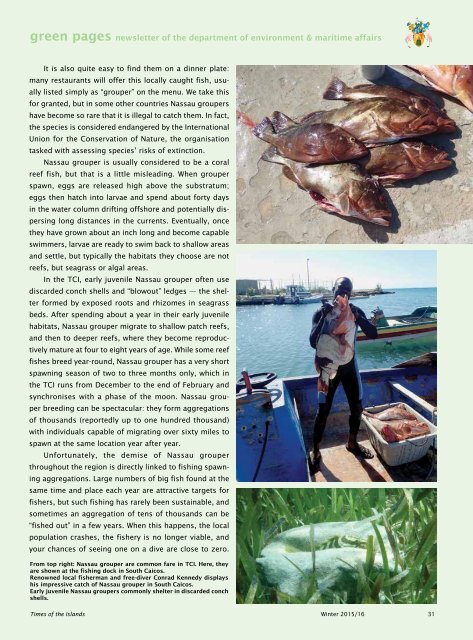Times of the Islands Winter 2015-16
Presents the "soul of the Turks & Caicos Islands" with in-depth features about local people, culture, history, environment, businesses, resorts, restaurants and activities.
Presents the "soul of the Turks & Caicos Islands" with in-depth features about local people, culture, history, environment, businesses, resorts, restaurants and activities.
Create successful ePaper yourself
Turn your PDF publications into a flip-book with our unique Google optimized e-Paper software.
green pages newsletter <strong>of</strong> <strong>the</strong> department <strong>of</strong> environment & maritime affairs<br />
It is also quite easy to find <strong>the</strong>m on a dinner plate:<br />
many restaurants will <strong>of</strong>fer this locally caught fish, usually<br />
listed simply as “grouper” on <strong>the</strong> menu. We take this<br />
for granted, but in some o<strong>the</strong>r countries Nassau groupers<br />
have become so rare that it is illegal to catch <strong>the</strong>m. In fact,<br />
<strong>the</strong> species is considered endangered by <strong>the</strong> International<br />
Union for <strong>the</strong> Conservation <strong>of</strong> Nature, <strong>the</strong> organisation<br />
tasked with assessing species’ risks <strong>of</strong> extinction.<br />
Nassau grouper is usually considered to be a coral<br />
reef fish, but that is a little misleading. When grouper<br />
spawn, eggs are released high above <strong>the</strong> substratum;<br />
eggs <strong>the</strong>n hatch into larvae and spend about forty days<br />
in <strong>the</strong> water column drifting <strong>of</strong>fshore and potentially dispersing<br />
long distances in <strong>the</strong> currents. Eventually, once<br />
<strong>the</strong>y have grown about an inch long and become capable<br />
swimmers, larvae are ready to swim back to shallow areas<br />
and settle, but typically <strong>the</strong> habitats <strong>the</strong>y choose are not<br />
reefs, but seagrass or algal areas.<br />
In <strong>the</strong> TCI, early juvenile Nassau grouper <strong>of</strong>ten use<br />
discarded conch shells and “blowout” ledges — <strong>the</strong> shelter<br />
formed by exposed roots and rhizomes in seagrass<br />
beds. After spending about a year in <strong>the</strong>ir early juvenile<br />
habitats, Nassau grouper migrate to shallow patch reefs,<br />
and <strong>the</strong>n to deeper reefs, where <strong>the</strong>y become reproductively<br />
mature at four to eight years <strong>of</strong> age. While some reef<br />
fishes breed year-round, Nassau grouper has a very short<br />
spawning season <strong>of</strong> two to three months only, which in<br />
<strong>the</strong> TCI runs from December to <strong>the</strong> end <strong>of</strong> February and<br />
synchronises with a phase <strong>of</strong> <strong>the</strong> moon. Nassau grouper<br />
breeding can be spectacular: <strong>the</strong>y form aggregations<br />
<strong>of</strong> thousands (reportedly up to one hundred thousand)<br />
with individuals capable <strong>of</strong> migrating over sixty miles to<br />
spawn at <strong>the</strong> same location year after year.<br />
Unfortunately, <strong>the</strong> demise <strong>of</strong> Nassau grouper<br />
throughout <strong>the</strong> region is directly linked to fishing spawning<br />
aggregations. Large numbers <strong>of</strong> big fish found at <strong>the</strong><br />
same time and place each year are attractive targets for<br />
fishers, but such fishing has rarely been sustainable, and<br />
sometimes an aggregation <strong>of</strong> tens <strong>of</strong> thousands can be<br />
“fished out” in a few years. When this happens, <strong>the</strong> local<br />
population crashes, <strong>the</strong> fishery is no longer viable, and<br />
your chances <strong>of</strong> seeing one on a dive are close to zero.<br />
From top right: Nassau grouper are common fare in TCI. Here, <strong>the</strong>y<br />
are shown at <strong>the</strong> fishing dock in South Caicos.<br />
Renowned local fisherman and free-diver Conrad Kennedy displays<br />
his impressive catch <strong>of</strong> Nassau grouper in South Caicos.<br />
Early juvenile Nassau groupers commonly shelter in discarded conch<br />
shells.<br />
<strong>Times</strong> <strong>of</strong> <strong>the</strong> <strong>Islands</strong> <strong>Winter</strong> <strong>2015</strong>/<strong>16</strong> 31

















